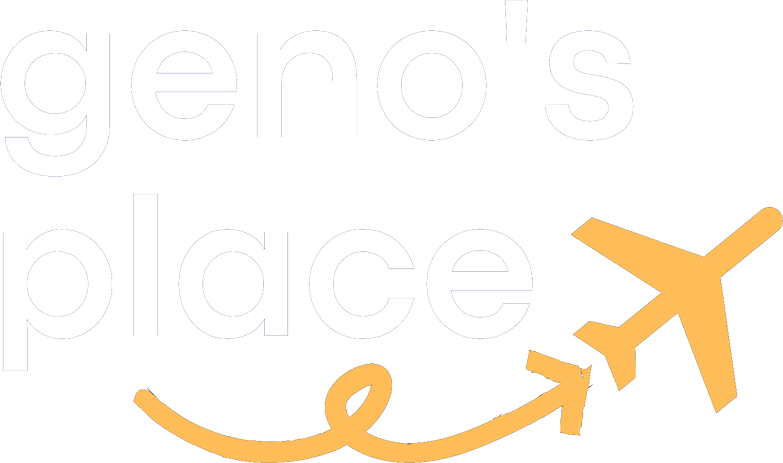I was sitting in my wheelchair on the side of the Malecón, the main road that runs along the Havana shore. I was playing sex- tionary – guessing the names of amorous activities as described to me by a quasi English-speaking taxi driver, while my non- Spanish speaking travel buddy was on the other side of town making a money exchange with a total stranger. What could possibly go wrong? You don’t find this kind of fun in tour brochures. In fact, when we went to Cuba, June of 2012, it wasn’t even legal for Americans to be there.
My adventure started as a conversation with my friend Mark, another wheelchair user, with whom I made an expedition to Mount Everest base camp years previous. He was a seasoned traveler and the kind of guy who could always find the bright side in questionable situations. I really valued his opinion.
I told Mark, “I’m thinking of going to Cuba.”He immediately responded, “You should go, I did.”
This was the catalyst that ignited the reaction. There was no stopping me now. I was both excited and downhearted at the same time. Since Mark had already been there, I could claim no bragging rights as “the first” person with a disability, amongst our mutual friends, to visit Cuba. I could, however, ride his coattail and venture into territory distant from the US by both politics and geography.
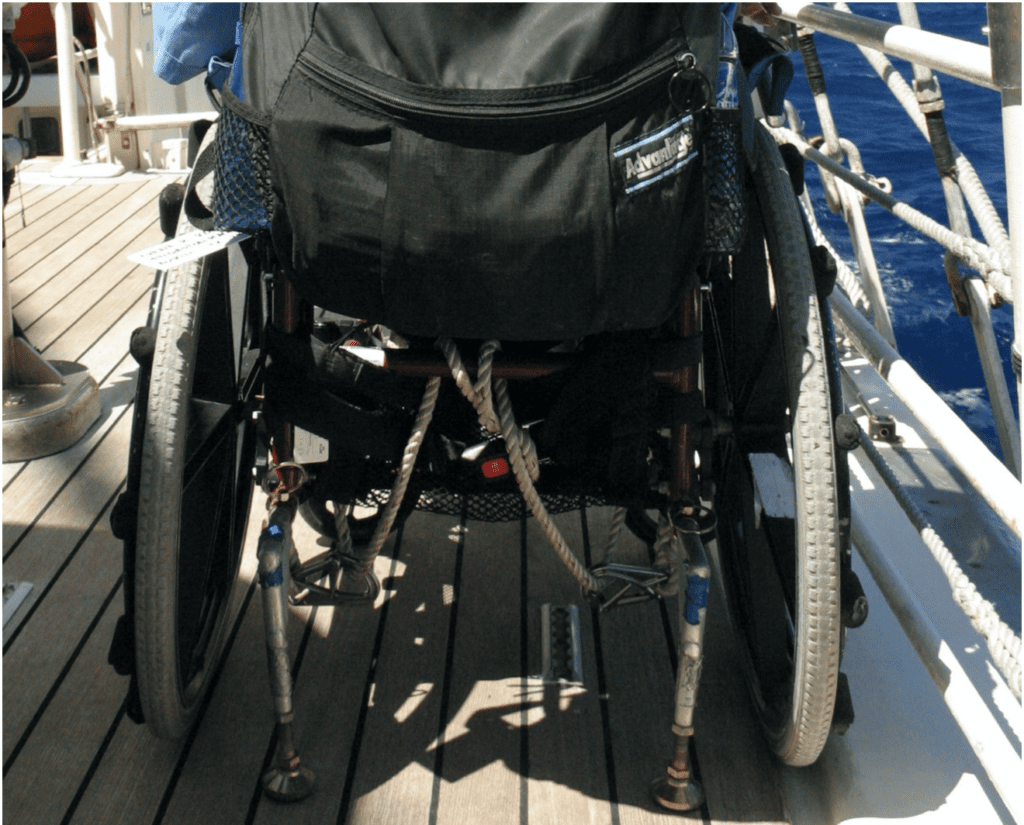
I wanted to go to Cuba because I was looking for a culturally unique experience. Though every country has such opportunities, Cuba is significantly different from the other 42 countries in which I’ve traveled. Just planning to go there was a real adventure. Mark gave me some basic tips, but I would have to develop my own plan as my budget was tighter than his. Since flying there directly from US was illegal at that time, I couldn’t even search for flights on the web. US travelers willing to take a chance on being fined $10,000, fly first to another country. From there, they fly to Cuba.
One of my travel rules is that “Whenever I travel out of the US, I make sure to use a route that will take me places I have not yet visited.” For the trip to Cuba, I arranged a flight to the Bahamas for me and my travel buddy, Isaac. I bought vouchers from a Canadian travel agency for the short flight to Cuba from the Bahamas.
I scoured the web for information on Americans traveling to Cuba. Since travel to Cuba was illegal for most Americans, there were plenty of people on the web sharing their exploits and offering suggestions for skirting the pesky laws. It appeared that the Cubans didn’t stamp American passports when they cross the border. That meant, unless we did something stupid or unfortunate, we wouldn’t get caught coming back to the states. When we did eventually fly, I learned that local services were quite limited. Isaac had to pick me up, out of my wheelchair, and carry me up the moveable stairs to get into the plane. Other airlines contract with a service to get me into a plane seat, but no, not this one.
When traveling internationally, I need to either use credit cards or exchange cash for the currency used in the country in which I’m traveling. Cuba has a cash economy, so we couldn’t use credit cards there. Trying to exchange American money for Cuban currency, we would get a big hit, at least a13% penalty. So I thought the best thing to do to limit the exchange rate cost was to exchange American money for euros, in the Bahamas. Then in Cuba, we would exchange euros for Cuban currency, lowering our conversion costs to closer to 7%.
After I figured out a strategy to reduce our financial risk, the next step was to secure lodging. Finding information on expensive, large hotels was easy. But hotels just aren’t my lodging style. I did some research and found there’s something called a “casa particular.” They are rooms in someone’s house or apartment that can be rented. The owners may or may not live there. Some serve breakfast and/or dinner for an additional cost. Some provide laundry and other services. Still, because the internet is an expensive service in Cuba, casa particular vendors are usually contacted through a broker. Those brokers may not speak English. Even if we speak the same language, we don’t always have the same
understanding. I started off looking for a first-floor room. Then I learned that to Cubans, a first-floor room is up one flight of steps. I needed to start my search over again, this time looking for a ground floor room.
After I struggled with internet issues, language issues, colloquial issues, and yes, of course, accessibility issues, I finally found the Lachi and Yeni House. It wasn’t wheelchair accessible, but its location was a great redeeming feature, so I booked two rooms for $25 /room/night.
Our room doorways were too narrow for me to roll through without taking the rear wheels off my wheelchair. Years of traveling prepared me for such a situation. Ever since my brother Mike and I designed “sea legs” for my chair, they’ve been getting a lot of use. I call them sea legs because I use them a lot when sailing. Even with the
wheelchair wheels on, I put these sea legs on to keep the chair from flipping over backwards while on the deck of a ship, in rolling waves. I can also just drop the sea legs down, take the wheels off, and the chair remains sitting level. Then Isaac just lifts the back of the chair a little and rolls me through doorways.
Our bathroom was also inaccessible. To use the shower, Isaac first put the wheelchair, without wheels but with sea legs locked in place, in the shower, then carried me onto it. The shower water was usually cold but Isaac claimed at one time he actually had hot water. He was tempted to cross out the symbol, representing hot water, on the business card of this place. Then one day we had no water. Then the fan became finicky and didn’t want to work right. It was a mini-drama, waiting to see what would go wrong next. This was typical of the third world lodging. I experienced it in other countries, expected it in Cuba and embraced it for the humor it provided.
Our hosts were great. One told us to call her Jenny – she spoke some English. She had a teenage son, Hector, and a six-year old son. Hector’s girlfriend Talia (Ta-lee-a) also lived there. Talia’s mother is a nurse at a rehab hospital. The man who worked in the house spoke almost no English. Though it was difficult to understand them at times, they were all very friendly.
Breakfast at our casa particular was always a large bowl of assorted fruits – pineapple, banana, papaya, mango and guava, as well as fried eggs and tomatoes and, of course, Cuban coffee. For dinner, we had chicken the first night but fish or lobster all other nights. Staples included rice, black beans, a plate of sliced tomatoes, cucumbers, and shredded cabbage. We also had fried vegetable chips from some sort of root vegetable. They served veggie mix that looked like thick potato pancake. Our hosts were gracious enough to allow us to film them cooking and they even showed us recipes for some of the dishes. I took pictures of the recipes, in Spanish, and brought them home to translate.
Malecón
Our casa particular was right on the Malecón, the main road that runs along the Havana shore. We were within walking distance to plazas, parks, and historic sights. If we took a step out our door and turned to the right, we could see the tip of Castillo de los Tres Santos Reyes Magnos del Morro, which was about a 10 minute walk away. If, instead, we had turned to the left, we could see the Hotel Nacional, about 3 kilometers away.

Frequently we sat on Jenny’s front doorstep and watched as the sun set over the bay. Oftentimes a trumpeter would play on the other side of the road. What a beautiful setting. During one of our first evenings, in front of our casa particular, we were watching the sunset as a taxi slowed down and pulled up next to us. The driver and his partner offered us their services. We didn’t need them that evening but made arrangements to have them pick us up the following morning.
The next day, Raynel and Pedro were right on time. Isaac and I got our picture taken in front of it. They showed up in their yellow ‘32 Ford, the one they drove the previous night. This is a classic car like the many modified in Cuba in the 30’s and 40’s as roadsters. The Beach boys even wrote a song about it, My Little Deuce Coop. Classic cars were ubiquitous as were coconut taxis, little 3 –wheel vehicles
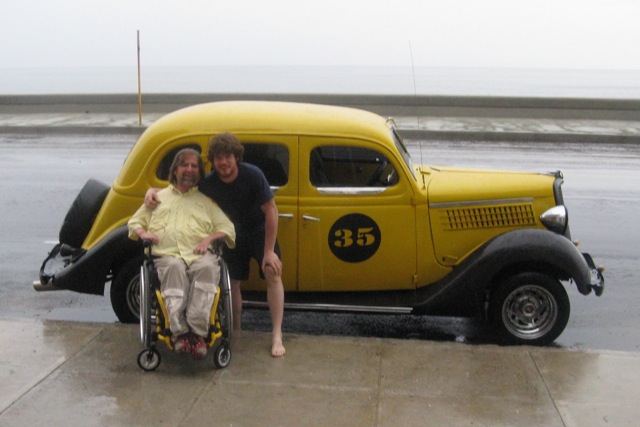
Raynel was the slender quiet one while Pedro was the older, shall we say, “hair challenged” one of the two. He reminded me of a carnival barker. He solicited customers. He knew how to approach people and was quite gregarious.
He opened both doors of his Ford and told us that I would fit right in. He thought I could stay in my wheelchair and we could just roll the chair into the car. I knew different. We told him our destination and negotiated a price. They offered to help us get into the car. I told them, “No, Isaac can do it.” With that, Isaac let the sea legs on the wheelchair down, locked them in place, and took my rear wheels off. Pedro and Ryan looked at us as if watching a magic act. Isaac maneuvered me and my chair into the taxi, and we were off.
Classic cars are part of the charm of Cuba. Isaac really loved classic cars so Raynel let Isaac drive his 1935 Ford and later in the day, Pedro convinced the owner of a 1957 Buick to let Isaac drive that. The owner towered over Pedro. I didn’t understand what was being said, but the Buick owner seemed to reluctantly acquiesce to Pedro’s convincing ways. These cars are over a half century old and their owners are very protective of them.
Viñales
Viñales is a popular tourist destination as it is on the UNESCO World Heritage List. Founded in 1875, this town is known for its tobacco farms. We stopped by one just outside Viñales on the road to Los Jazmines to see a fully operating secadero (drying house) in which tobacco leaves are cured from February to May. The staff gives brief explanations and you can buy loose cigars. The gentleman rolling cigars gave me one as a gift.
Cueva del Indio
Just 5 kilometers north of Viñales, is an ancient indigenous dwelling of Cueva del Indio. It was rediscovered in 1920. Motorboats now ply the underground river through the electrically lit cave. At first, they refused to take me on to the boat. They said it was impossible. Isaac not only convinced them otherwise but also got them to discount my ticket. We had to take the wheels off my chair to fit it in the boat. Once again, my sea legs came it quite handy
After leaving Viñales, we met a farmer on the roadside who was selling blocks of fresh cheese. Each block came with package of fresh fruit paste that looks and taste likes Quince. The two were a delightful combination on a cracker
Cigars
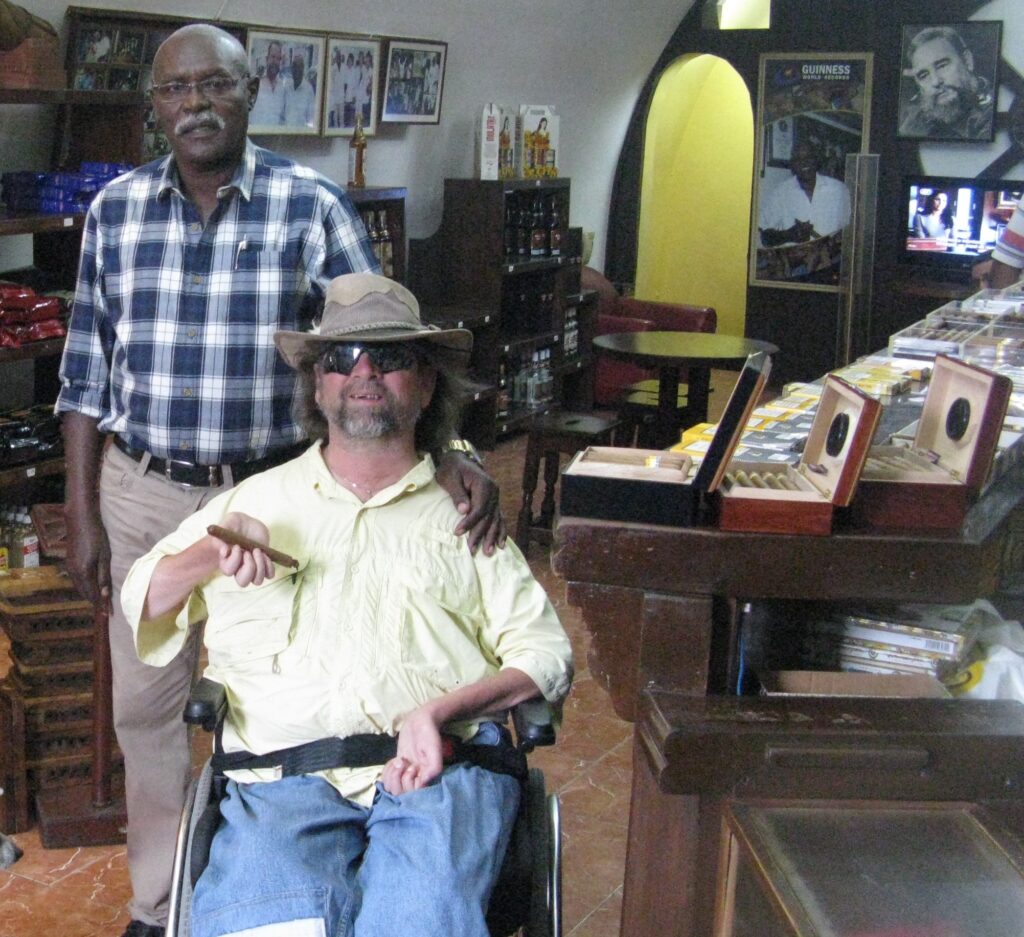
People on the street tried to sell us cigars. We were forewarned of their questionable authenticity. We decided to heed that advise and buy only at genuine cigar stores. All genuine Cuban cigars are hand- rolled by trained experts before being packed in tightly sealed cedar boxes and classified into 42 different types and sizes. We did stop at a cigar shop where Isaac got a free cigar, coffee and they even offered him rum. I was at the other end of the factory and didn’t know they were giving away that stuff till Isaac told me later that night. Thanks, Isaac. There is a cigar store across from Hotel Nacional that has better prices but a much more limited selection. While in Havana we met Jose (Cueto) Castelar at La Triada at Parque Morro- Cabaña is a Guinness record holder for making the longest cigar – it measured 81.80 m (268 ft. 4 in). I was told he used a honey mixture to glue the tobacco. The cigar maker in Viñales (picture on left) used a pine sap mixture.
We wandered over to the Plaza de Armas. There was a popular secondhand book market very close by. We made a friend we called teacher, because, well he was a teacher and we couldn’t pronounce his name. As we talked, one musician approached us and started playing his guitar, then another started playing, then a woman joined in and started singing.
As we enjoyed our Cuban vacation, I realized I should have exchanged more US currency for euros, in the Bahamas. A teacher at the park said he could us .90/USD from restaurant owner/friend. But Pedro, the Taxi driver, had a friend going to Argentina who offered us .93/USD. This was a great opportunity for us to exchange money at a great rate.
In order to exchange some money, Isaac had to leave me, then go with Raynel to meet his friend the Argentinian. I stayed with Pedro on the Malecón. Sitting in my manual wheelchair, unable to use my hands, I couldn’t maneuver at all. I had the ocean at my back as I faced the Malecón, a four-lane highway. While Pedro greeted old friends and tourists, trying to drum up business, he started asking me some unusual questions.
Pedro told me he had customers that came to Cuba, from all over the world, and that all these clients had their own proclivities. He said it in a way that was distinctly “Pedro”, with a Cuban accent. I just looked at him inquisitively. He went on to explain that he wanted to be sure to meet his clients’ needs but needed help with translations. Again, I looked at him like a dog would look at someone when they’ve just been deprived of their favorite chew toy – their owner’s leather shoes. Pedro said his customers had certain sexual requests and that he wanted to be sure to take them to the appropriate vendor. So here we are, on a major road in Havana, in broad daylight, and Pedro says to me, while thrusting his hips and waving his arms, “What is it called when a man does this to a woman?” I did my best to give an American name to that amorous activity.
Pedro continued to demonstrate various sexual activities, as if playing a version of that animated game – dictionary, and asked for their English title. After a few rounds of sex-tionary, I was getting a bit uncomfortable. Perhaps it might have been different if I was mobile and could leave whenever I wanted, but instead I was a captive audience.
Every Ernest Hemingway fan knows he had some favorite haunts in Cuba. One was Sloppy Joe’s, in Havana. He also enjoyed Sloppy Joe’s in Key West, Florida, Key West being a bastion of free thinkers even in the thirties. I’ve been to both of them!
Here’s a little known fact – Havana has a China Town. There was a significant influx of Chinese into Cuba starting in 1847 to work the sugarcane fields. This China Town arch, small as it is, is probably a token hommage to that immigration. Other than that, there are no Chinese and only a few Chinese restaurants.
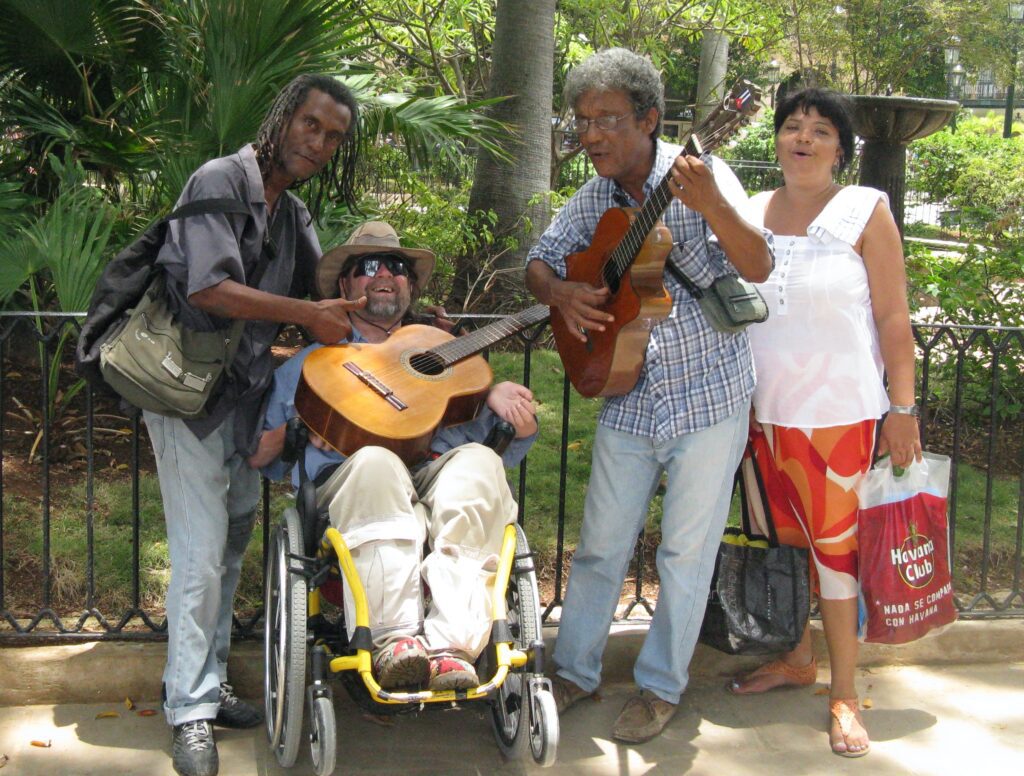
The night before leaving Cuba, we packed as much as possible. Isaac really wanted to bring a box of Cuban cigars home, but I convinced him otherwise. We did see warnings indicating we could be jailed and fined up to $10,000 for smuggling contraband (which included cigars). There was no American Embassy in Cuba to help us out if we got into a jam. On the other hand, Cubans welcomed American tourist and their money and would not want to discourage future tourism. I said, ”Isaac, if we get caught, I know your old man wouldn’t have a problem with it, but your mother will kill me.” Isaac then picked up a handful of free cigars we had been given, saying, “There is no f**cking way we are leaving Cuba without these!” He was a compassionate man and soon won me over with his exuberance. I clearly understood his desire, but he just graduated from Case Western and I would hate to see a youthful indiscretion mar his otherwise unblemished record. Finally, I said, “Well, if I can’t stop you, I might as well show you how to do it right.” When it comes to smuggling, customs officials have seen just about every trick in the book. Still, there is a certain satisfaction I derive trying to out-fox the fox.
Ever since 9-11, when terrorist brought down the twin towers in New York, airport security has been tight world-wide. I’ve found that if I wanted to get my eating utensils and wheelchair repair tools past security, I needed to be a little clever. This time, I would be smuggling cigars rather than wheelchair repair tools. My wheelchair was built by welding a lot of tubes together. I showed Isaac how we could insert cigars into the tubes and hide them from custom officials.
The next day, we said good-bye to our hosts, used our remaining money to pay for taxi and exit fees, dropped luggage at the airline desk and headed for customs. Their equivalent of our TSA agent, gave me a pretty good once-over. They even examined my wheelchair cushion. They used a mirror to see the underside of my chair. Once satisfied, they waived us through. Isaac and I waited till we were on the plane before congratulating ourselves on a job well done. It was good-bye to Cuba and hello to planning my next adventure.
